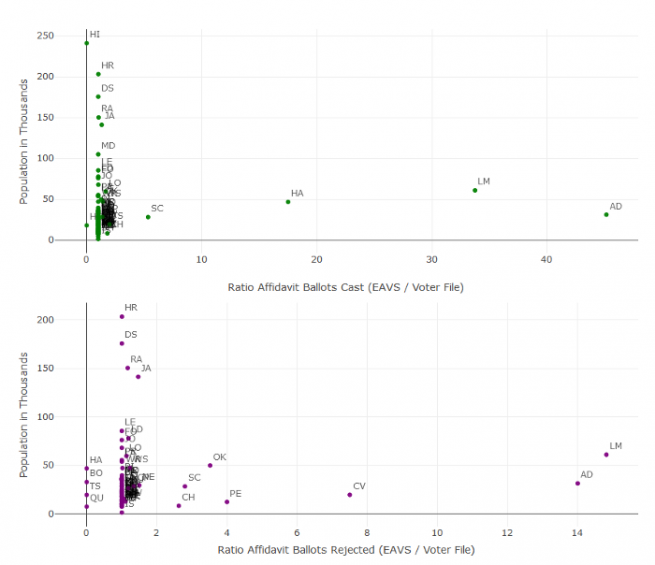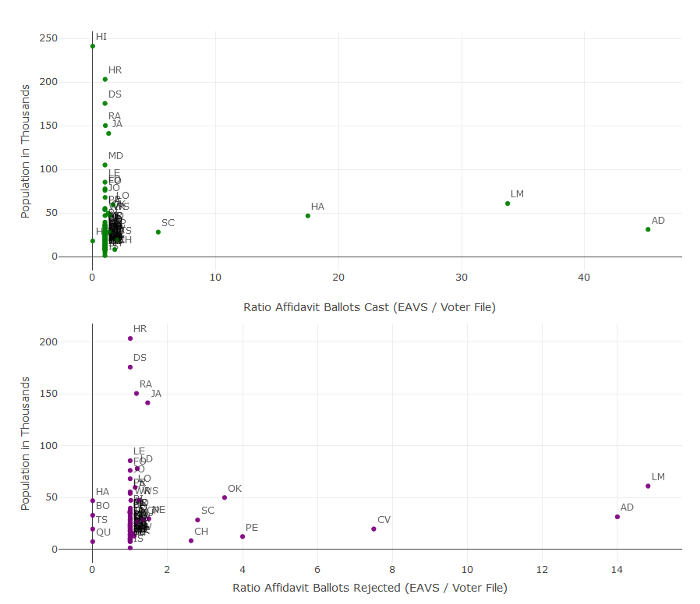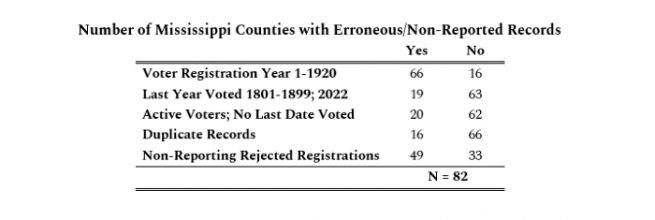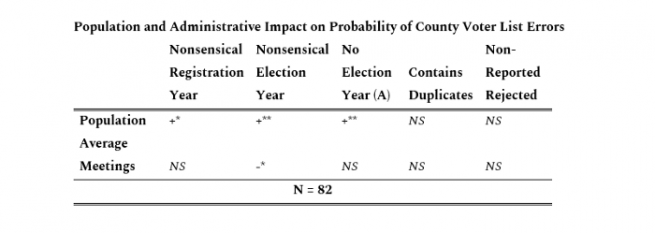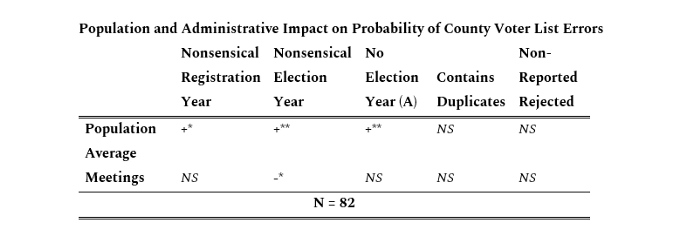Managing Voter Registration Lists the Hybrid Way
The Case of Mississippi
The MIT Election Data and Science Lab helps highlight new research and interesting ideas in election science, and is a proud co-sponsor of the Election Sciences, Reform, & Administration Conference (ESRA).
Thessalia Merivaki and Sean Conner recently presented a paper at the 2018 ESRA conference entitled, “Managing Voter Registration Lists the Hybrid Way: The Case of Mississippi.” Here, they summarize their analysis from that paper.
Accurate voter lists matter because they facilitate access to the electoral process, and indicate efficient voter list maintenance. Errors in voter records often result from local variation in voter list management practices, which are inevitable given the highly decentralized structure of election administration in the United States. To minimize these errors and improve voter record-keeping and the list maintenance process, the Help America Vote Act (HAVA) of 2002 required states to adopt statewide voter registration databases.
Continued data inconsistencies and missing or incomplete information indicate that states or localities are not updating voter registration lists efficiently. We argue that the structure of these voter registration databases can impact the accuracy of voter records, and consequently the efficiency of voter list maintenance.
States have had varied responses to HAVA’s requirement, with some adopting a “top-down” and others a “bottom-up” structure. Top-down structures are maintained at the state level and accessed by localities. This means that, as data are entered in one jurisdiction, any changes are instantly visible and available to any other, since all jurisdictions have access to the statewide list. Because they are more centralized, this suggests that local officials have limited room for discretion when it comes to entering and updating voter registration records.
Bottom-up lists, on the other hand, are kept by localities, then transmitted to a master file at the state level. There are advantages to this structure, including lower administrative costs and easier identification of registered voters who move between jurisdictions, but it also means that records can only be compared and merged at predefined intervals. Because the responsibility to process, update, and maintain voter records might be more fragmented, this leaves increased room for discretion — as well as errors. This structure may be justified, however, as the best way to ensure that localities maintain control of their jurisdictions’ administrative and electoral dynamics.
A few states have adopted hybrid structures that require coordination between state and local election officials in entering and updating voter records. These systems may be in the unique position to inherit the benefits of both these structures, but they may also be prone to the challenges associated with both. It remains largely unknown how these hybrid structures are defined or operated, and what administrative benefits they might offer for maintaining voter lists.
How Accurate are Mississippi’s Voter Registration and Turnout Records?
Mississippi’s voter registration database is managed as a hybrid system. The state maintains a Statewide Election Management System (SEMS), hosted on a central platform with information supplied by local jurisdictions. Responsibility for the system is divided between the county circuit clerks and five election commissioners, who must authorize changes on the county’s voter records.
The state’s election officials do not have statutory authority to manage voter records, but regulate access to SEMS, granting county circuit clerks broad access and editing privileges. County election officials must receive annual training on voter list maintenance and SEMS, and are required by law to conduct regular voter list maintenance meetings; how often these should occur is dictated by the county’s population size, with smaller counties required to hold them less often than bigger ones.
States and localities also report voter registration and turnout data to the EAC’s bi-annual Election Administration and Voting Surveys (EAVS). The data are produced from SEMS, so we expect that estimates of voter registration and voting records will match when we compare data reported to the EAC with the statewide voter list.
We find that the estimates of active and inactive voters, absentee ballots requested, and returned ballots overall do match when we compare the 2016 EAVS and a snapshot of Mississippi’s voter file from October 2016, despite a few counties appearing as outliers because of overreported estimates of inactive registered voters in the EAVS.
The highest inconsistencies in the reported estimates appear when we compare rates of rejected voter registrations (above) and the rates of provisional ballots cast and rejected (below). These discrepancies strongly indicate issues with proper data reporting to SEMS, particularly in a few jurisdictions that claim they “never reject” voter registration applications.
The estimates of provisional ballots cast and rejected are particularly important because they are issued when a voter’s registration status cannot be verified at the polls. Such inconsistencies make it difficult to determine why voters did not cast a regular ballot in 2016, or whether provisional voting rates were high or low in Mississippi. When we followed up with the counties that reported zero provisional ballots cast in either the EAVS or SEMS, we were told that they simply did not report the estimates to SEMS. They did, however, retain copies of the ballots. This indicates the impact of a hybrid data management structure on retaining and updating records, especially when we move beyond voter registration estimates such as active and inactive registered voters, which seems to be the state’s record-keeping priority.
Are Some Counties More Efficient in Cleaning Voter Rolls Than Others?
The way management databases are structured affects the level of oversight the state has over local officials, who process and report voter registration records. States can increase oversight by adopting uniform procedures or statutorily requiring that localities report data directly into the voter registration database. Absent this state oversight, local discretion may be unavoidable, leading to variation in how localities maintain voter rolls, and thus increasing the likelihood of inaccurate records.
In that respect, states with top-down structures can have more oversight over localities than those with bottom-up or hybrid structures. That said, it’s possible that voter list maintenance is a bigger challenge for some jurisdictions, regardless of the state’s management structure or the existence of uniform rules and procedures regarding voter list maintenance. Given the constraints localities face in terms of capacity and expertise, they may not be able to efficiently perform their tasks, even if the state requires them to. Localities vary in terms of population size, demographics, and human and financial resources. It is unreasonable to expect that every jurisdiction within a state conducts voter list maintenance at the same time and frequency. Missing data, inconsistent reports, or data errors may suggest that cleaning voter records may be particularly challenging for some jurisdictions.
The most common errors and inconsistencies we found in Mississippi’s voter file involve nonsensical voter registration or voting dates, voters whose status is active with no record of voting, duplicate records, and unreported estimates of rejected voter registrations. The table below shows the number of counties with these sorts of voter record errors. 66 counties, for example, contained voter records with nonsensical voter registration: Sharkey County reportedly has 1,313 registered voters whose registration date is January 1, 1801. 1,258 of them are currently active voters —interesting, as Sharkey County’s population is only 4,552, with a total of 3,099 active registered voters.
To investigate whether small counties experience more challenges cleaning voter rolls, we run five bivariate logistic regressions with robust standard errors, clustered by county. The dependent variables are whether the county contains erroneous records or non-reported items, as described in the table above. The main independent variable is the county population; we also control for the number of voter list maintenance meetings that county elections officials are statutorily required to have per year, averaged by month.
A county’s population is positively correlated with the likelihood that its records contain nonsensical registration years, election years, or active voters without a voting date. While it appears that larger counties are more likely to contain nonsensical election dates, more voter list maintenance meetings decreased the likelihood of such errors, ceteris paribus.
Interestingly, neither population size nor the average number of voter list maintenance meetings predict whether the county’s records will contain duplicate records or zero rejected records. This suggests that county election officials may update records that involve active and inactive voters more rigorously than processing records of incomplete voter registration applications that may result in a rejected registration. We find no evidence that errors in the voter file are associated with issues in reporting voter registration and voting estimates in the 2016 EAVS.
This may be contrary to the expectation that erroneous records in the voter file are associated with inconsistent reporting of voter registration and turnout estimates. It’s likely, therefore, that voter list maintenance is “efficient” to the extent that it does not significantly impact the status of eligible voters when they turn out to vote. If a voter is “active” and shows up to cast a ballot, perhaps it is not a priority to correct the voter’s nonsensical voter registration date, but rather to ensure that the voter’s status remains “active”.
Implications for Reform and Election Administration
It is perhaps unrealistic to expect that voter registration lists will be 100% error-free. In the context of our study, there were just over 2 million active and inactive registered voters in the Mississippi voter file, 326,688 of which had no election date recorded. The errors we observed reflect discrepancies in how frequently data are updated by localities, as well as the attentiveness to correcting voter records with missing or incomplete information. The fact that erroneous and duplicate records appear only in specific counties strongly suggests that such issues are county-specific, rather than a statewide issue.
Our analysis suggests that a hybrid structure at the very least allows counties to make ad hoc decisions about how to maintain voter records. Election administration reform advocates strongly suggest the adoption of post-election audits, which Mississippi does not statutorily require — but the Secretary of State has announced that it will pilot the first statewide post-election audit to assess counties’ performances in the June 2018 primaries. This indicates that oversight may be necessary to ensure the quality of voter list maintenance under a hybrid structure, which may have similar implications for states that operate under a bottom-up structure.


